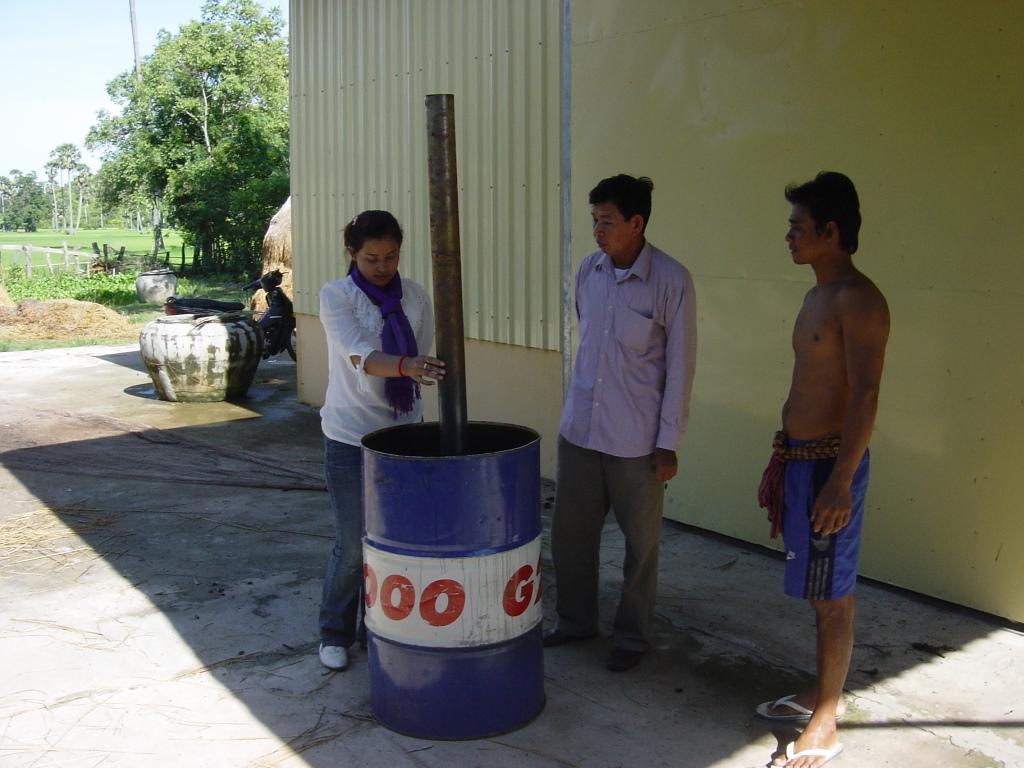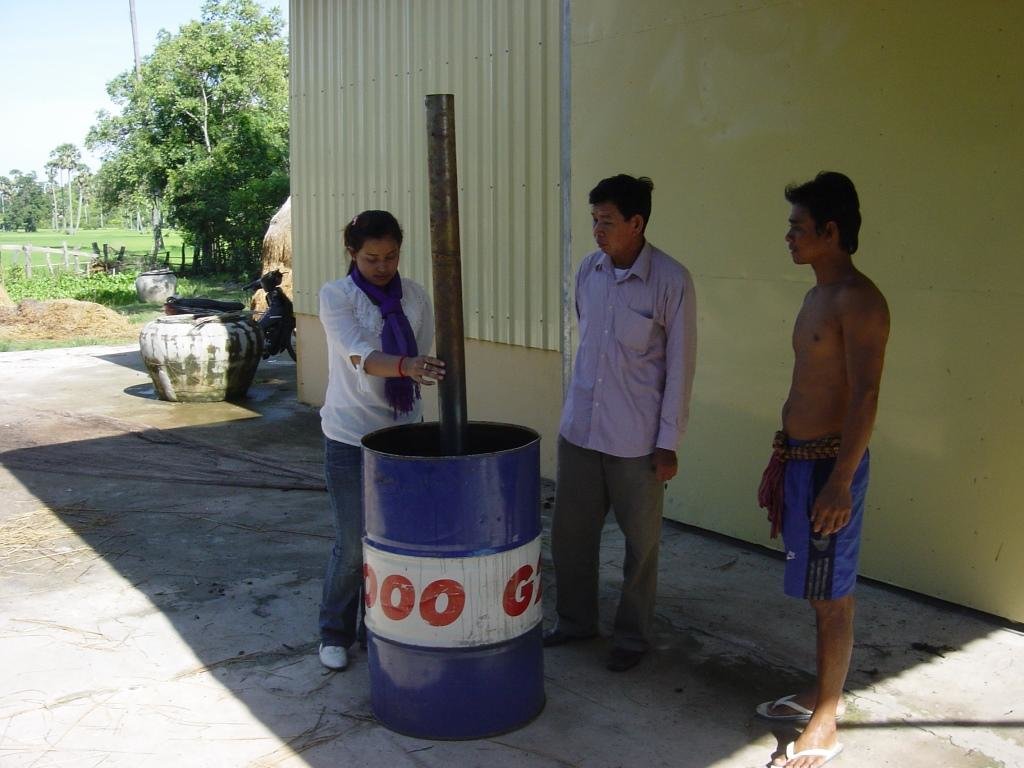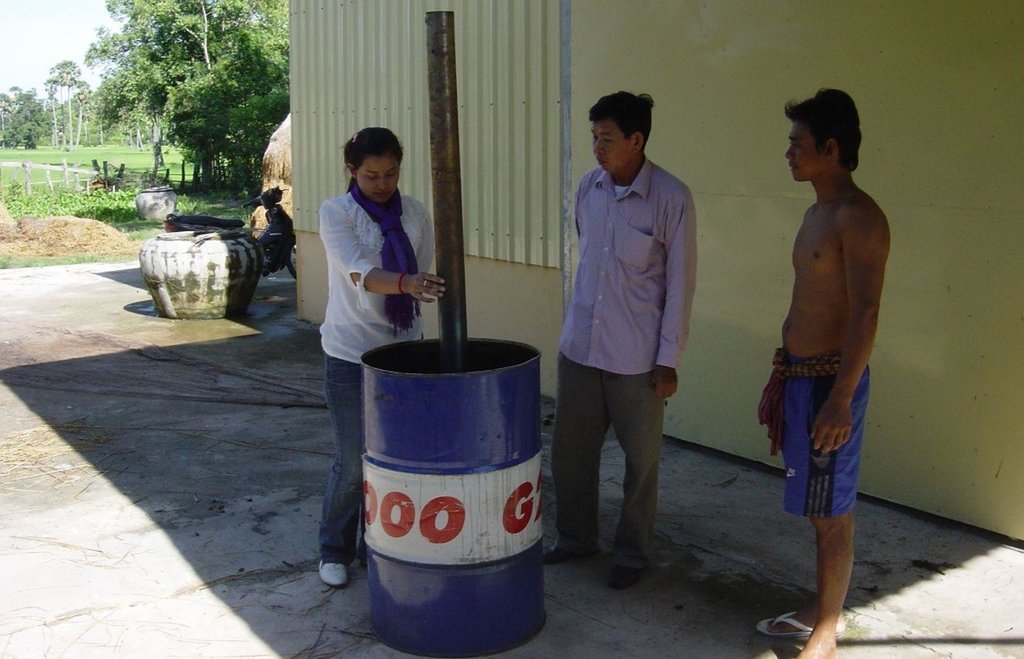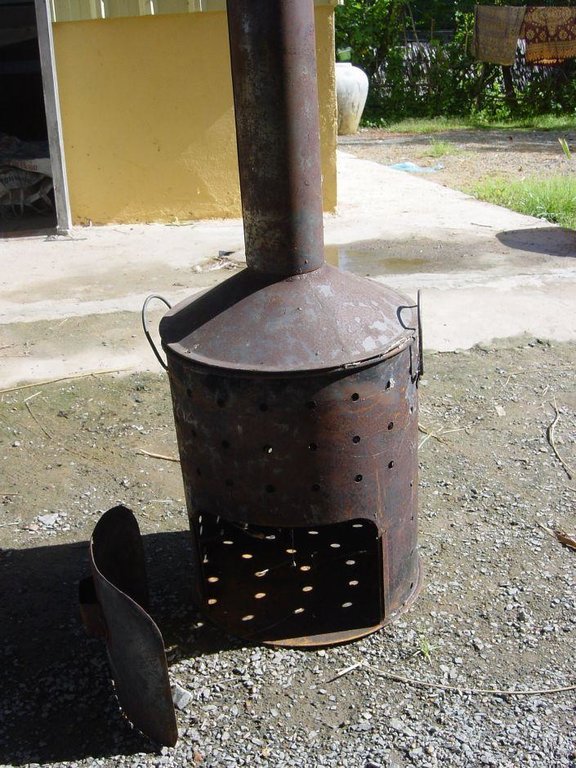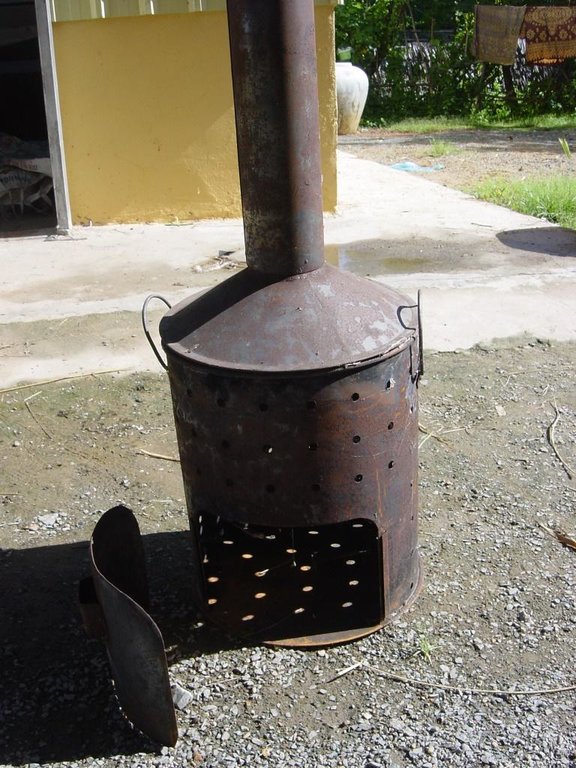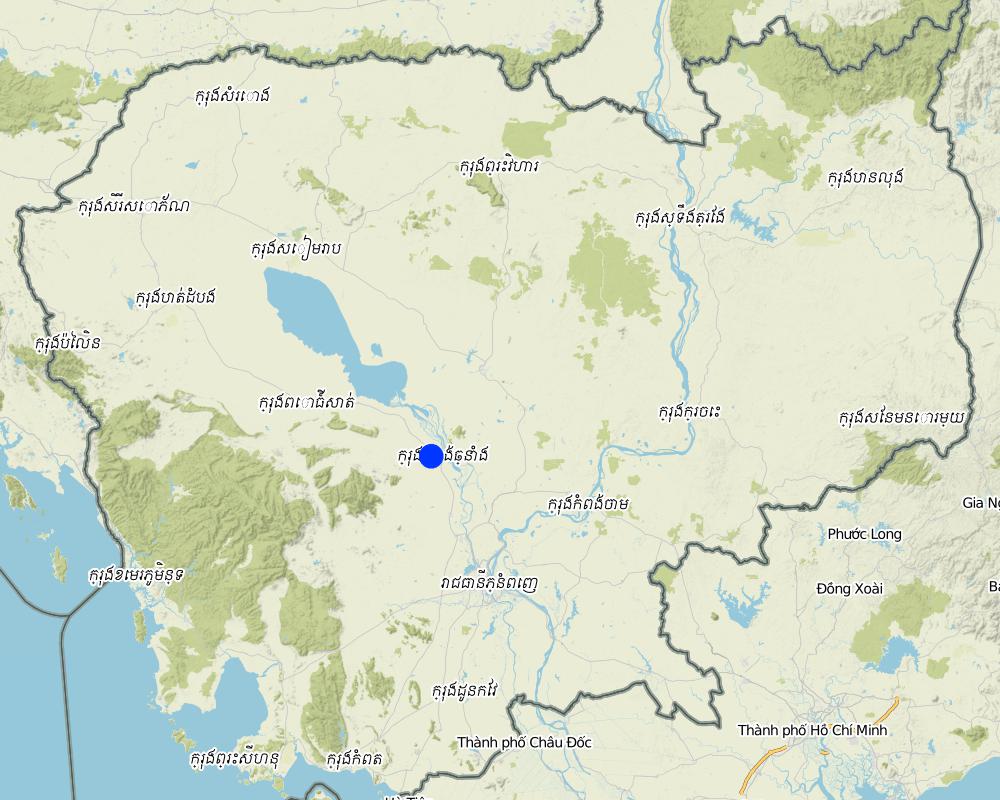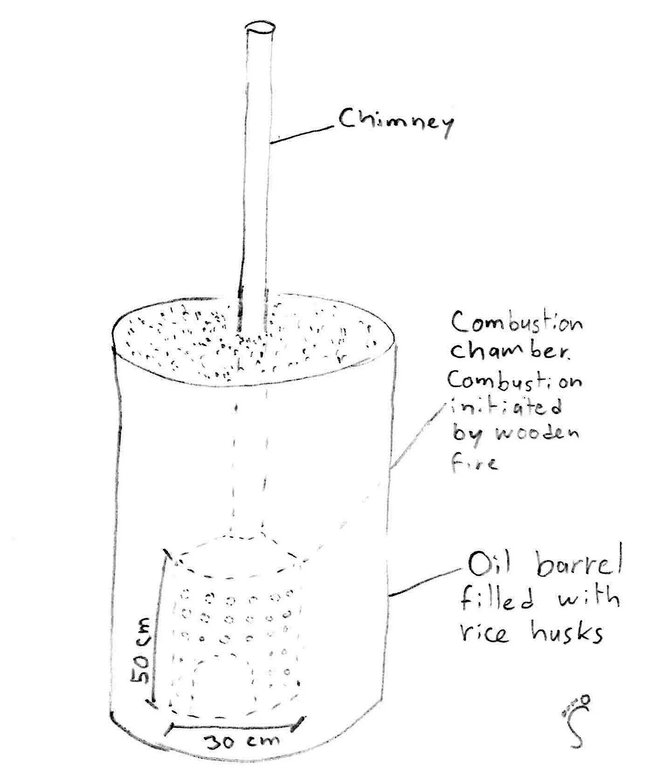Production and use of rice husk biochar in rice seed beds and vegetable production. [Camboja]
- Criação:
- Atualização:
- Compilador/a: Stefan Graf
- Editor: –
- Revisores: Alexandra Gavilano, Deborah Niggli
ការផលិត នឹងប្រើប្រាស់ជីធ្យូងអង្កាមលើថ្នាលសំណាបនឹងដំណំាបន្លែ (Khmer)
technologies_1229 - Camboja
Veja as seções
Expandir tudo Recolher tudo1. Informação geral
1.2 Detalhes do contato das pessoas capacitadas e instituições envolvidas na avaliação e documentação da tecnologia
Especialista em GST:
Khun Lean Hak
SOFDEC/LAREC, www.sofdec.org
Camboja
Especialista em GST:
Pith Khonhel
LAREC
Camboja
Especialista em GST:
Bin Sreytouch
SOFDEC
Nome da(s) instituição(ões) que facilitou(ram) a documentação/ avaliação da Tecnologia (se relevante)
Society for Community Development in Cambodia (SOFDEC) - CambojaNome da(s) instituição(ões) que facilitou(ram) a documentação/ avaliação da Tecnologia (se relevante)
Local Agricultural Research and Extension Centre (LAREC) - Camboja1.3 Condições em relação ao uso da informação documentada através de WOCAT
O compilador e a(s) pessoa(s) capacitada(s) aceitam as condições relativas ao uso de dados documentados através do WOCAT:
Sim
1.4 Declaração de sustentabilidade da tecnologia descrita
A tecnologia descrita aqui é problemática em relação a degradação da terra de forma que não pode ser declarada uma tecnologia de gestão sustentável de terra?
Não
2. Descrição da tecnologia de GST
2.1 Descrição curta da tecnologia
Definição da tecnologia:
Rice husks as well as empty seeds are pyrolised and used as a soil amendment in the rice seed beds and the vegetable gardens.
2.2 Descrição detalhada da tecnologia
Descrição:
Biochar is the residue left after the pyrolysis of any organic matter and is used as a soil amendment. Pyrolysis occurs when the organic matter is heated in anaerobic conditions, which is usually done in specially designed kilns. Sometimes it is also made in a conventional fire, which is extinguished before the char turns to ash. Agricultural wastes like rice husks or unfilled grains are mainly used. Biochar can have many positive effects on the soil and plants:
-It buffers the pH, and has usually a high pH due to theash content.
-Due to its porous structure, it holds water and serves as refuge for microorganisms.
-It absorbs and adsorbs nutrients, both cations and anions. They are available for the plant roots.
-It can increase the resistance of plants to diseases.
Due to all these effects, the increased yields are higher than those that can be achieved only through the nutrients contained in the Biochar itself. Biochar is and was used in many parts of the world as soil amendment, with some benefits persisting for centuries. In Cambodia it was used during the Pol Pot regime to reduce the smell of the human faeces that were used on the fields due to a lack of other fertilizers. Today research in the Biochar domain is increasing, especially since the discovery of the man-made terra preta soils in South America.
Biochar is mainly used to increase the fertility, water holding capacity and carbon content of the soil. The fact that the benefits of Biochar addition to the soil remain for several years, unlike chemical fertilizers, makes it attractive to farmers. Other purposes, like the increased resistance of plants to diseases and buffering of nutrients are also of importance.
Biochar was introduced or reintroduced trough different NGOs, JICA (Japanese International Cooperation Agency) in this case study. Because of knowledge exchange between farmers, a rice husk char/ash mix, as residue from the pottery baking, was used already in 2011. In 2013 JICA borrowed a Biochar kiln to the local farmer self-help group with a training, so they could produce Biochar by themselves. The inner part of the kiln (cf. technical drawing) is filled with wood and lit. It is then put into an empty oil barrel, which is filled with rice husks. The heat pyrolyses the husks from the bottom to the top of the barrel, and the gases are burned in the inner part of the kiln and the chimney. Just before the upper part is pyrolysed, the husks are extinguished. There is a weight loss of about 50 to 60 % caused by this process. The Biochar is added to the fields after ploughing, and the fields are harrowed. In this case study, Biochar is used both in rice seed beds and in a vegetable patch. Concentrations of 0.5 kg/m2 are used in the rice seed bed, and 2.5 kg for the vegetables. Due to the little available quantities of husks, Biochar is not applied to the field yet. The use of Biochar is spreading quickly from farm to farm
The analysed area is flat (slope < 2%), with a tropical climate (dry season from November to May and wet season from June to October), and the soils are mostly sandy or loamy. The soil has a low fertility, contains little organic matter, and acidifies. The area has been deforested a long time ago, and the groundwater table is rather high (1-2 m during the dry season, on the surface during wet season).
Due to climate change, farmers notice more erratic rainfall, temperature rises and more recurrent droughts. Rice is the predominant crop grown in the area, since it serves as staple food (mix subsistence and commercial activities). Cattle are usually grazing on the fields after the harvest, without much control. Thus the cattle grazes too often and too much on the same spot, leading to degradation.
The increasing migration rate (the young generation leaves the villages to work in the cities, garment industry or abroad) results in a decrease of available labour force in the area which has detrimental effects on the agricultural activities. Furthermore, the civil war in the 1970s (Khmer Rouge) led to the loss of agricultural knowledge. Several NGOs are trying to re-establish the knowledge.
2.3 Fotos da tecnologia
2.5 País/região/locais onde a tecnologia foi aplicada e que estão cobertos nesta avaliação
País:
Camboja
Região/Estado/Província:
Kampong Chhnang
Especificação adicional de localização:
Kraing Leav
Especifique a difusão da tecnologia:
- Uniformemente difundida numa área
Se a área precisa não for conhecida, indicar a área aproximada coberta:
- 0,1-1 km2
Comentários:
Area unknown and rapidly spreading.
Map
×2.6 Data da implementação
Caso o ano exato seja desconhecido, indique a data aproximada:
- menos de 10 anos atrás (recentemente)
2.7 Introdução da tecnologia
Especifique como a tecnologia foi introduzida:
- através de projetos/intervenções externas
Comentários (tipos de projeto, etc.):
It was introduced in 2010 by JICA, the Japanese International Cooperation Agency.
3. Classificação da tecnologia de GST
3.1 Principal/principais finalidade(s) da tecnologia
- Melhora a produção
3.2 Tipo(s) atualizado(s) de uso da terra onde a tecnologia foi aplicada

Terra de cultivo
- Cultura anual
Cultivo anual - Especificar culturas:
- legumes - outros
- vegetais - vegetais de folhas (saladas, couve, espinafre, outros)
- legumes - raízes (cenouras, cebolas, beterraba, outros)
- legumes - melão, abóbora ou aboborinha
- rice, cucumber
Número de estações de cultivo por ano:
- 1
Especifique:
Longest growing period in days: 210, Longest growing period from month to month: June-December
Comentários:
Major land use problems (compiler’s opinion): Soil fertility decline, water availability
Major land use problems (land users’ perception): Water availability. Interestingly the farmer says that soil fertility is not a problem, as the farmers know about the use of compost. The compost application is the problem.
Livestock is grazing on crop residues
In the vegetable patch the farmer plants cucumber, pumpkin, onion, watermelon and leaf vegetables in the early wet season, before planting rice.
3.4 Abastecimento de água
Abastecimento de água para a terra na qual a tecnologia é aplicada:
- Misto de precipitação natural-irrigado
3.5 Grupo de GST ao qual pertence a tecnologia
- Gestão integrada de fertilidade do solo
3.6 Medidas de GST contendo a tecnologia

Medidas agronômicas
- A2: Matéria orgânica/fertilidade do solo
3.7 Principais tipos de degradação da terra abordados pela tecnologia

Deteriorização química do solo
- Cn: declínio de fertilidade e teor reduzido de matéria orgânica (não causado pela erosão)
- Ca: acidificação

Degradação da água
- Ha: aridificação
Comentários:
Main causes of degradation: soil management (Ploughing and bare soil during dry season.), labour availability (Farmers go to work in the garment industry, in construction, or sell their labor elsewhere.)
Secondary causes of degradation: deforestation / removal of natural vegetation (incl. forest fires) (Deforestation happened many years ago.), overgrazing (Uncontrolled grazing during dry season.), change in temperature (More hot days according to UNDP and farmers.)
3.8 Redução, prevenção ou recuperação da degradação do solo
Especifique o objetivo da tecnologia em relação a degradação da terra:
- Reduzir a degradação do solo
4. Especificações técnicas, implementação de atividades, entradas e custos
4.1 Desenho técnico da tecnologia
Especificações técnicas (relacionada ao desenho técnico):
Biochar kiln. In the inner part, the combustion chamber, a wooden fire is lit. The burning chamber is then placed in the oil barrel, which is filled with rice husks. The heat pyrolyses the husks, the gas burn in the chamber and chimney. When pyrolysis is almost completed, the char is extinguished.
Kampong Chhnang
Date: 2014
Technical knowledge required for field staff / advisors: high
Technical knowledge required for land users: moderate (When farmers only buy Biochar the required technical knowledge is low.)
Main technical functions: increase in organic matter, increase in nutrient availability (supply, recycling,…)
Secondary technical functions: improvement of surface structure (crusting, sealing), improvement of topsoil structure (compaction)
Manure / compost / residues
Material/ species: Rice husk Biochar (together with compost, which he already did before)
Quantity/ density: 0.5-2.5
Remarks: Entity: kg/m^2. Distributing on fields and harrowing.
Autor:
Stefan Graf, Switzerland
4.2 Informação geral em relação ao cálculo de entradas e custos
Outro/moeda nacional (especifique):
Riels
Se for relevante, indique a taxa de câmbio do USD para moeda local (por exemplo, 1 USD = 79,9 Real): 1 USD =:
4000,0
Indique a média salarial da mão-de-obra contratada por dia:
5.00
4.3 Atividades de implantação
| Atividade | Periodicidade (estação do ano) | |
|---|---|---|
| 1. | biochar kiln |
4.4 Custos e entradas necessárias para a implantação
| Especifique a entrada | Unidade | Quantidade | Custos por unidade | Custos totais por entrada | % dos custos arcados pelos usuários da terra | |
|---|---|---|---|---|---|---|
| Equipamento | kiln | 1,0 | 50,0 | 50,0 | ||
| Custos totais para a implantação da tecnologia | 50,0 | |||||
| Custos totais para o estabelecimento da Tecnologia em USD | 0,01 | |||||
4.5 Atividades recorrentes/manutenção
| Atividade | Periodicidade/frequência | |
|---|---|---|
| 1. | Biochar making | Whenever there is time |
| 2. | Adding Biochar to the fields after the compost was plowed in, and harrowing. | Yearly, before planting. |
4.6 Custos e entradas necessárias pata a manutenção/atividades recorrentes (por ano)
| Especifique a entrada | Unidade | Quantidade | Custos por unidade | Custos totais por entrada | % dos custos arcados pelos usuários da terra | |
|---|---|---|---|---|---|---|
| Mão-de-obra | labour | 1,0 | 20,0 | 20,0 | 100,0 | |
| Equipamento | machine use | 1,0 | 0,25 | 0,25 | 100,0 | |
| Material vegetal | rise husks | 1,0 | 4,0 | 4,0 | 100,0 | |
| Custos totais para a manutenção da tecnologia | 24,25 | |||||
| Custos totais de manutenção da Tecnologia em USD | 0,01 | |||||
Comentários:
The costs are indicated per unit; a unit is one biochar kiln used on 1 a. The costs were calculated in 2014 for the vegetable beds, where the farmer uses around 2.5 kg/m2. He also uses Biochar on the rice seedling bed, with concentrations of around 0.5 kg/m2, 5 times less than in the vegetable patch. In the vegetable patch the farmer plants cucumber, pumpkin, onion, watermelon and leaf vegetables in the early wet season, before planting rice.
4.7 Fatores mais importantes que afetam os custos
Descreva os fatores mais determinantes que afetam os custos:
The factors affecting the cost the most are the biochar kiln, and the amount of added Biochar.
5. Ambiente natural e humano
5.1 Clima
Precipitação pluviométrica anual
- <250 mm
- 251-500 mm
- 501-750 mm
- 751-1.000 mm
- 1.001-1.500 mm
- 1.501-2.000 mm
- 2.001-3.000 mm
- 3.001-4.000 mm
- > 4.000 mm
Especificações/comentários sobre a pluviosidade:
1486.45 mm 2013 in Kampong Chhnang
Zona agroclimática
- Subúmido
Thermal climate class: tropics. 27° to 35°C
5.2 Topografia
Declividade média:
- Plano (0-2%)
- Suave ondulado (3-5%)
- Ondulado (6-10%)
- Moderadamente ondulado (11-15%)
- Forte ondulado (16-30%)
- Montanhoso (31-60%)
- Escarpado (>60%)
Formas de relevo:
- Planalto/planície
- Cumes
- Encosta de serra
- Encosta de morro
- Sopés
- Fundos de vale
Zona de altitude:
- 0-100 m s.n.m.
- 101-500 m s.n.m.
- 501-1.000 m s.n.m.
- 1.001-1.500 m s.n.m.
- 1.501-2.000 m s.n.m.
- 2.001-2.500 m s.n.m.
- 2.501-3.000 m s.n.m.
- 3.001-4.000 m s.n.m.
- > 4.000 m s.n.m.
5.3 Solos
Profundidade do solo em média:
- Muito raso (0-20 cm)
- Raso (21-50 cm)
- Moderadamente profundo (51-80 cm)
- Profundo (81-120 cm)
- Muito profundo (>120 cm)
Matéria orgânica do solo superficial:
- Médio (1-3%)
- Baixo (<1%)
5.4 Disponibilidade e qualidade de água
Lençol freático:
< 5 m
Qualidade da água (não tratada):
Água potável precária (tratamento necessário)
5.5 Biodiversidade
Diversidade de espécies:
- Baixo
5.6 Características dos usuários da terra que utilizam a tecnologia
Orientação de mercado do sistema de produção:
- Subsistência (autoabastecimento)
- misto (subsistência/comercial)
Rendimento não agrícola:
- 10-50% de toda renda
Nível relativo de riqueza:
- Pobre
- Média
Indivíduos ou grupos:
- Indivíduo/unidade familiar
Gênero:
- Mulheres
- Homens
Indique outras características relevantes dos usuários da terra:
Land users applying the Technology are mainly common / average land users
Population density: 10-50 persons/km2
Annual population growth: 0.5% - 1%
Off-farm income specification: handicraft, remittances and factory work
5.7 Área média de terrenos utilizados pelos usuários de terrenos que aplicam a Tecnologia
- < 0,5 ha
- 0,5-1 ha
- 1-2 ha
- 2-5 ha
- 5-15 ha
- 15-50 ha
- 50-100 ha
- 100-500 ha
- 500-1.000 ha
- 1.000-10.000 ha
- > 10.000 ha
É considerado pequena, média ou grande escala (referente ao contexto local)?
- Média escala
5.8 Propriedade de terra, direitos de uso da terra e de uso da água
Propriedade da terra:
- Comunitário/rural
- Indivíduo, não intitulado
Direitos do uso da terra:
- Comunitário (organizado)
- Indivíduo
Direitos do uso da água:
- Acesso livre (não organizado)
Comentários:
Land users have a title that is not recognized by the state.
5.9 Acesso a serviços e infraestrutura
Saúde:
- Pobre
- Moderado
- Bom
Educação:
- Pobre
- Moderado
- Bom
Assistência técnica:
- Pobre
- Moderado
- Bom
Emprego (p. ex. não agrícola):
- Pobre
- Moderado
- Bom
Mercados:
- Pobre
- Moderado
- Bom
Energia:
- Pobre
- Moderado
- Bom
Vias e transporte:
- Pobre
- Moderado
- Bom
Água potável e saneamento:
- Pobre
- Moderado
- Bom
Serviços financeiros:
- Pobre
- Moderado
- Bom
6. Impactos e declarações finais
6.1 Impactos no local mostrados pela tecnologia
Impactos socioeconômicos
Produção
Produção agrícola
Comentários/especificar:
According to the farmer, 50 to 70 % yield increase on his vegetable patches.
Renda e custos
Despesas com insumos agrícolas
Comentários/especificar:
Rice husks become a demanded product instead of a waste. On the other hand, less pesticides are needed.
Carga de trabalho
Comentários/especificar:
Biochar has to be made and added to the fields.
Impactos socioculturais
Segurança alimentar/auto-suficiência
Comentários/especificar:
Increased production, healthier plants/less pests.
Estado de saúde
Comentários/especificar:
Less pesticides needed.
contribution to human well-being
Comentários/especificar:
Increased income, less expenses on pesticides.
Impactos ecológicos
Solo
Umidade do solo
Comentários/especificar:
Plants can stand a short dry spell better if grown with Biochar.
Ciclo e recarga de nutrientes
Comentários/especificar:
A waste, rice husks, is returned to the soil. Biochar also adsorbs and absorbs nutrients.
Matéria orgânica do solo/carbono abaixo do solo
Comentários/especificar:
The carbon from Biochar has a long half-life period in the soil .
Biodiversidade: vegetação, animais
Controle de praga/doença
Comentários/especificar:
Less pesticides needed.
6.3 Exposição e sensibilidade da tecnologia às mudanças climáticas graduais e extremos/desastres relacionados ao clima (conforme o ponto de vista dos usuários da terra)
Mudança climática gradual
Mudança climática gradual
| Estação do ano | aumento ou diminuição | Como a tecnologia lida com isso? | |
|---|---|---|---|
| Temperatura anual | aumento | bem |
Extremos (desastres) relacionados ao clima
Desastres meteorológicos
| Como a tecnologia lida com isso? | |
|---|---|
| Temporal local | não conhecido |
| Tempestade de vento local | não conhecido |
Desastres climatológicos
| Como a tecnologia lida com isso? | |
|---|---|
| Seca | bem |
Desastres hidrológicos
| Como a tecnologia lida com isso? | |
|---|---|
| Inundação geral (rio) | não bem |
Outras consequências relacionadas ao clima
Outras consequências relacionadas ao clima
| Como a tecnologia lida com isso? | |
|---|---|
| Período de crescimento reduzido | bem |
6.4 Análise do custo-benefício
Como os benefícios se comparam aos custos de implantação (do ponto de vista dos usuários da terra)?
Retornos a curto prazo:
levemente positivo
Retornos a longo prazo:
positivo
Como os benefícios se comparam aos custos recorrentes/de manutenção(do ponto de vista dos usuários da terra)?
Retornos a curto prazo:
positivo
Comentários:
The costs for the pyrolysis kiln were not borne by the land user. But as the farmer of this case study wants to build an own kiln as soon as the NGO needs it again, it is positive.
6.5 Adoção da tecnologia
Comentários:
100% of land user families have adopted the Technology with external material support
100 land user families have adopted the Technology with external material support
Considering only the farmers applying the technology with this stove. Other farmers buy Biochar, or burn the rice husks and extinguish them. But those farmers are nearly impossible to quantify as it changes quickly. The support was the kiln, which is only a small part of the costs.
Considering only the farmers applying the technology with this stove. Other farmers buy Biochar, or burn the rice husks and extinguish them. But those farmers are nearly impossible to quantify as it changes quickly.
In another area of Cambodia where the Ministry of Agriculture, Forestry and Fisheries (MAFF) is doing Biochar research, there was such a strong adoption of Biochar use that there are no more control areas. In Kampong Chhnang, the use of Biochar starts to spread now.
6.7 Pontos fortes/vantagens/oportunidades da tecnologia
| Pontos fortes/vantagens/oportunidades na visão do usuário da terra |
|---|
| Less insect damages where Biochar is applied. |
| Good growth of vegetables, with increased yields especially for onions. |
| The rice seedlings are stronger, and the roots break less while transplanting, and the plants recover quickly. |
| The plants survive a short dry spell better. |
| Pontos fortes/vantagens/oportunidades na visão do compilador ou de outra pessoa capacitada |
|---|
| Soil amendment with long-term effect, as Biochar has a long half-life period. |
| Buffering and raising of the pH, especially in sandy soils. |
| Less washing out of nutrients. |
6.8 Pontos fracos, desvantagens/riscos da tecnologia e formas de superá-los
| Pontos fracos/desvantagens/riscos na visão do usuário da terra | Como eles podem ser superados? |
|---|---|
| Substrate to make Biochar (rice husks) is difficult to find in the area in big amounts, as only small rice mills are working there. |
Rice husks are wasted in other places. Networking with other villages. Use other (waste) sources of organic matter like leaves. |
| Increased workload for the Biochar production (compensated by the increased yields). | Use a bigger kiln to decrease the workload. |
| Pontos fracos/vantagens/riscos na visão do compilador ou de outra pessoa capacitada | Como eles podem ser superados? |
|---|---|
| The energy produced during the pyrolysis is wasted. | Use it to power engines or as heating source. This would only be viable on large-scale kilns. |
7. Referências e links
7.1 Métodos/fontes de informação
- visitas de campo, pesquisas de campo
- entrevistas com usuários de terras
Quando os dados foram compilados (no campo)?
14/08/2014
7.2 Referências às publicações disponíveis
Título, autor, ano, ISBN:
Ithaka Journal
Disponível de onde? Custos?
www.ithaka-institut.org
Título, autor, ano, ISBN:
Biochar foundation
Disponível de onde? Custos?
www.britishbiocharfoundation.org
Links e módulos
Expandir tudo Recolher tudoLinks
Não há links
Módulos
Não há módulos


